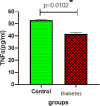Diabetes mellitus can cause cardiomyopathy disorders by inducing the aging pathway
- PMID: 34249265
- PMCID: PMC8244613
- DOI: 10.22038/ijbms.2021.54783.12287
Diabetes mellitus can cause cardiomyopathy disorders by inducing the aging pathway
Abstract
Objectives: In this study, cardiovascular disorders were examined with a focus on the aging pathway and autophagy involvement in cardiac samples isolated from male rats with type 2 diabetes mellitus.
Materials and methods: In the present study, male Wistar rats became diabetic with the help of a high-fat diet. Gene and protein expression levels (to evaluate Tumor Necrosis Factor-α, TNF-α) were measured by the ELISA method. Nrf2, p38, and GSK-3β proteins in cardiac tissue samples were measured by the western blotting method. Autophagy examination was performed with immunofluorescence staining. Finally, quantitative results were calculated using statistical analysis.
Results: The expression of beta-galactosidase genes had a significant increase in the diabetic group (P=0.0001). However, there was no significant difference in the expression of the SERCA2a gene between the diabetic and control groups. In terms of protein expression, the amount of TNF-α protein in the diabetic group was significantly different from that of the control group (P=0.0102). The expression levels of p38, Nrf2, and GSK-3β proteins increased compared with the control group. The use of the LC3 immunofluorescence staining technique revealed that autophagy increased in the diabetic group.
Conclusion: Type 2 diabetes mellitus in rats will increase aging in cardiac cells. Examination of the signaling pathway indicates that this effect is related to the increase of ROS and the activity of the signaling pathway. In response, the cardiac cells try to maintain their homeostasis by increasing autophagy and decreasing inflammatory cytokines.
Keywords: Aging; Autophagy; Cardiac; Cardiomyopathy; Diabetes mellitus; Signaling pathway.
Conflict of interest statement
The authors declare that no conflicts of interest exist.
Figures




Similar articles
-
1,25-Dihydroxyvitamin-D3 prevents the development of diabetic cardiomyopathy in type 1 diabetic rats by enhancing autophagy via inhibiting the β-catenin/TCF4/GSK-3β/mTOR pathway.J Steroid Biochem Mol Biol. 2017 Apr;168:71-90. doi: 10.1016/j.jsbmb.2017.02.007. Epub 2017 Feb 17. J Steroid Biochem Mol Biol. 2017. PMID: 28216152
-
Moringa oleifera Lam. seed extract protects kidney function in rats with diabetic nephropathy by increasing GSK-3β activity and activating the Nrf2/HO-1 pathway.Phytomedicine. 2022 Jan;95:153856. doi: 10.1016/j.phymed.2021.153856. Epub 2021 Nov 16. Phytomedicine. 2022. PMID: 34856477
-
Roles of TNF-α, GSK-3β and RANKL in the occurrence and development of diabetic osteoporosis.Int J Clin Exp Pathol. 2015 Oct 1;8(10):11995-2004. eCollection 2015. Int J Clin Exp Pathol. 2015. PMID: 26722385 Free PMC article.
-
Type 2 diabetes mellitus induced autophagic response within pulmonary tissue in the rat model.Bioimpacts. 2023;13(1):43-50. doi: 10.34172/bi.2022.22183. Epub 2022 Jun 8. Bioimpacts. 2023. PMID: 36817001 Free PMC article.
-
Urocortin attenuates myocardial fibrosis in diabetic rats via the Akt/GSK-3β signaling pathway.Endocr Res. 2016 May;41(2):148-57. doi: 10.3109/07435800.2015.1094489. Epub 2016 Mar 2. Endocr Res. 2016. PMID: 26934363
Cited by
-
Putative effect of melatonin on cardiomyocyte senescence in mice with type 1 diabetes mellitus.J Diabetes Metab Disord. 2022 Jan 31;21(1):353-359. doi: 10.1007/s40200-022-00982-9. eCollection 2022 Jun. J Diabetes Metab Disord. 2022. PMID: 35673474 Free PMC article.
References
-
- Rawshani A, Rawshani A, Franzén S, Eliasson B, Svensson A-M, Miftaraj M, et al. Mortality and cardiovascular disease in type 1 and type 2 diabetes. N Engl J Med. 2017;376:1407–1418. - PubMed
-
- Ryden L, Ferrannini G, Mellbin L. Risk factor reduction in type 2 diabetes demands a multifactorial approach. Eur j Prev Cardiol. 2019;26:81–91. - PubMed
-
- Murtaza G, Virk HUH, Khalid M, Lavie CJ, Ventura H, Mukherjee D, et al. Diabetic cardiomyopathy-A comprehensive updated review. Prog Cardiovasc Dis. 2019;62:315–326. - PubMed
LinkOut - more resources
Full Text Sources
